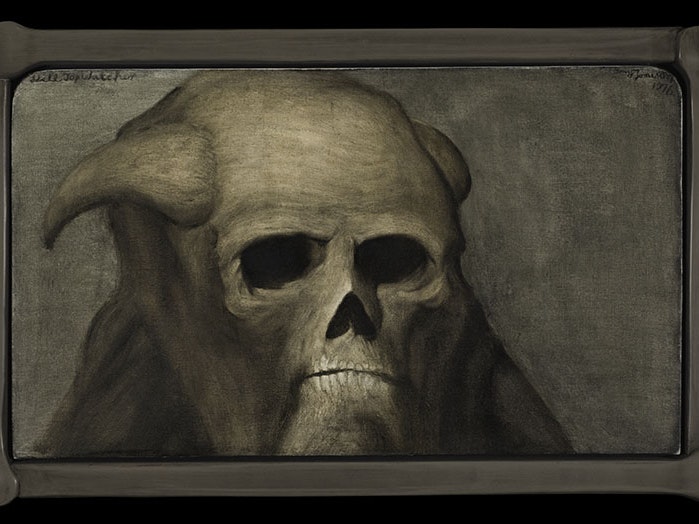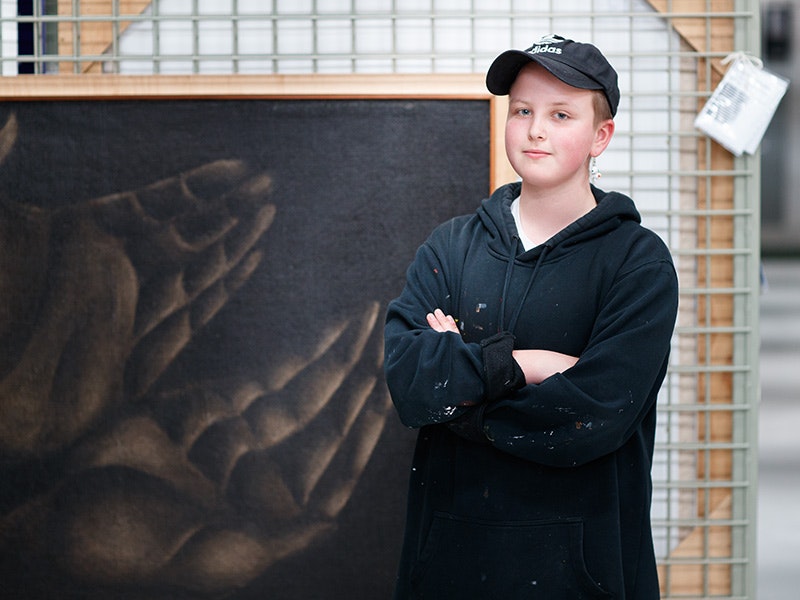
Tony Fomison: Lost in the Dark
An exhibition of Tony Fomison’s paintings, featuring monsters, misfits, and medical deformities that explores what it means to be an outsider.
Closed
18 Aug – 4 Nov 2018
Exhibition Ngā whakaaturanga
Free museum entry for New Zealanders and people living in New Zealand
Open every day 10am-6pm
(except Christmas Day)
Free museum entry for New Zealanders and people living in New Zealand
“The themes in his work always have a place in society – especially today where so many people are outcasts from their own countries.”
Aroha Millar is one of the students who helped co-create Tony Fomison: Lost in the Dark. Here, they discuss the experience as well as the artist.
Aroha Millar in front of Tony Fomison, Salvator mundi, 1970, oil on hessian on board. Te Papa (1993-0018-1). Photo by Kate Whitley, 2018. Te Papa
He painted monsters, and created this family of outcasts. He thought he was an outcast, so he created this whole family of outcasts, perhaps to feel like he didn’t feel alone.
It shows he was looking for people that were like him – maybe not physically but mentally and emotionally. Being able to relate to other people and understand what people are going through is really important.
The themes in his work always have a place in society – especially today where so many people are outcasts from their own countries. It helps us try to understand what they’re going through, and making little families of their own. Especially with important people telling us to stick with what we know and with the people we’ve been put into groups with. It’s a learning opportunity for us to look at people who don’t feel like they have a place.
Mark Adams, Portrait of Tony Fomison taken November 1974 at 17 Gunston Street, Freemans Bay, 1974. Te Papa (O.003190)
It’s definitely been different from sitting in an art class. I’ve really enjoyed hearing the different opinions on his art – what it means to other people and how they express it.
I think we created a lot of chaos! I really enjoy that Te Papa is trying to bring in the voices of younger people. These are the people that are going to be looking after the art in the future, and it’s important that they can see these works and help other people understand what they’re about.
I didn’t really know about Fomison, which is why I’m glad to be a part of this exhibition, because I do really enjoy his work.
They’d be able to reflect and listen to what other people – not just curators or art students, but regular people – have to say about the work. You realise that you don’t have to be particularly artistic to talk about art – it’s there for everyone to enjoy and start a conversation.
The students who have been involved in the exhibition have made it particularly easy for people to voice their own opinions about his art in the gallery. We’ve created a response wall, which I’ve really enjoyed working on, that has questions that anyone can answer.
I want people to be able to see what other people think about Fomison’s work. Sometimes you walk into a gallery and it’s really one-sided, so I hope we can break that wall. I’m really excited to see what our ideas will look like in the exhibition, rather than lots of scribbles on a page.
I was originally thinking of going down the fine arts route, but I love the thinking behind art, and the conversation that it can create, so I’d like to continue looking at that.

An exhibition of Tony Fomison’s paintings, featuring monsters, misfits, and medical deformities that explores what it means to be an outsider.
Closed
18 Aug – 4 Nov 2018
Exhibition Ngā whakaaturanga

“I think much of what he paints is an expression of feelings too big for your body. He makes these things that impress upon you from the outside. That can feel better than something emerging from the inside, because there is nowhere to go if something’s inside of you.”